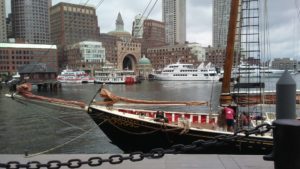As good as local sourcing is, there are some goods that need to be transported long-distances. Whether they are too much in demand and ingrained in the culture or just because a place is not self-sufficient, for example, coffee just doesn’t grow in most of the United States and the one place it does is Hawaii. Many goods need to be imported to Britain or Ireland, as well as other islands. Trade is also good for the world, fostering communication and connection between people and places.
But moving all of that stuff around is bad for the environment. Cargo ships are big, heavy and often run under flags of convenience, where registration is cheap and inspections can be few and far between. They also spend a lot of time in international waters, where they don’t have to follow many environmental regulations, burning extremely dirty fuels called “bunker fuels”.
One way to make international trade greener is to revive the use of sail power to move cargo. If it seems a little low-tech, don’t be fooled — any sailing ship is a sophisticated, fine-tuned machine with hundreds of variations from around the world perfectly adapted to local weather, sea conditions, depth and geography and the Royal Navy’s need for ships during the Napoleonic Wars played a major role in developing the Industrial Revolution.

Steam power only overtook sail power as the means of moving the majority of the world’s cargo in the early 20th century. Clipper ships were competitive cargo haulers until the Suez Canal opened. Modern Diesel-powered container ships, such as the MV Ever Given, which was famously grounded in the Suez Canal recently, is only slightly faster than a clipper and some modern ships are slower. The difference is that a modern vessel will never become becalmed or delayed by contrary winds.
Modern ships have many advantages over their 19th century predecessors. Radio and GPS can help them plot courses around storms or heavy seas, avoiding hazards that claimed the lives of many sailors in the past, while winch systems mean hoisting sails, putting in reefs or stowing them is less labor intensive. In fact, all the infrastructure for transporting cargo on and off the ship can be left on the shore. Because of their small size, sailing ships will not be confined to using the big container ports larger ships do. This will ease congestion in ports, while spreading out port jobs.
Sail power doesn’t need to be done by replica clipper ships that would be at home in a maritime museum — or a bottle — although a wooden hull and canvass sails are made from renewable resources. Many sail training vessels used by modern navies, such as the US Coast Guard’s Eagle, have steel hulls, as did some commercial sailing vessels. Today, modern racing boats are made from materials like carbon fiber and feature sails made from artificial materials like nylon and kevlar. Experiments are being made with technologies like rotarsails and turbosails to supplement motors. There are even ideas like “windmill ships” floating around where a ship-mounted turbine is used to produce electricity to power motors, although this seems inherently rather inefficient.
While there are several companies involved in hauling cargo, at present I only know of one that specializes in selling products shipped sustainable: Shipped By Sail.